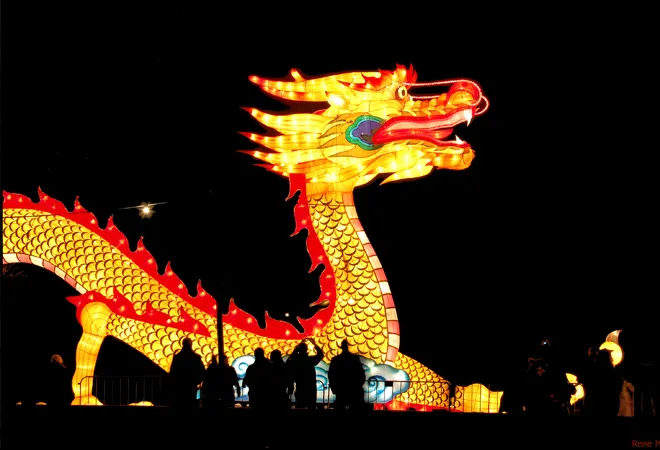-
CENTRES
Progammes & Centres
Location
The BRI initiative sits perfectly to balance two strategic objectives by leveraging China’s economic might and using it as in instrument to advance its diplomatic control in the region.

Image Source: Alias/Flickr
The poetic Chinese yi dai yi lu translates into the Belt and Road Initiative (BRI) in English. From its introduction to the world by President Xi Jinping in his September 2013 address at Kazakhstan's Nazarbayev University, the 'Silk Road Economic Belt' has mutated hastily and come to be called as 'One Belt and One Road Initiative' (OBOR) or 'Belt and Road Initiative' (BRI). OBOR/BRI is 21st century's most forthcoming and ambitious global initiative, which China proclaims as a 'community of common destiny' for nation states. For this article, we would use the term BRI. The Chinese central leadership backs the BRI and all the Chinese official statements and speeches endorse the BRI in its totality. The BRI has become the main instrument of Chinese grand strategy and the primary foreign policy instrument with states of Asia, Europe and Africa.
The BRI derives much importance critically within the complex geopolitical geographical borders of Central and South Asian states, where the Chinese are experiencing the maximum pushback both from regional powers like India and from the local population of disputed and controlled regions. The BRI roadmap in Central and South Asian context is best understood as a banyan tree with falling branches cementing the growth of the tree and rooting it firmly in the regional setting. The satellite initiatives like 'Digital Silk Road' and 'Silk Road of Satellites' are prime examples of these underpinnings. With several education and research centers manifesting themselves such as 'International Silk Road Think-Tank Association' and formation of 'Advancing the Development of OBOR,' a centrally led small group, indicates the resolve of the Chinese leadership and the resonance of BRI at the highest levels.
The BRI derives much importance critically within the complex geopolitical geographical borders of Central and South Asian states, where the Chinese are experiencing the maximum pushback both from regional powers like India and from the local population of disputed and controlled regions.
China's philosophy for BRI can be broken down into two primary strategic objectives. One, a need towards securing China's energy supply lines. Currently, 80% of China's energy imports and trade moves through the Malacca Strait. The BRI provides a supply diversification with detours for transporting oil and gas and an alternative trading route into Europe. The current investments in Central Asia and South Asia in pipelines have already demonstrated the BRI scope, reach and potential in securing and compensating China's fear towards securing its energy requirements. Secondly, many Chinese experts have argued in response to America's pivot to Asia and push in East Asia, that China must augment its power position by shifting into the Eurasian continent and enhancing its footprint beyond its borders. The PLA General Liu Yazhou asserted in 2001 that advancing westward was "a historical necessity for the Chinese nation, and it is also our destiny." <1>
The BRI initiative sits perfectly to balance these two strategic objectives by leveraging China’s economic might and using it as in instrument to advance its diplomatic control in the region. This is simple to read into, as most of the poor countries have a genuine necessity for infrastructure development and China is using the BRI as bait and luring them in. Once trapped in Chinese debt, equity and investment, these poor Eurasian nation states are already finding it extremely difficult to challenge the political ambitions of the dragon and drive away its fire power.
This Chinese entrapment is also visible in some of the developed European states, and some of the European states have very much scaled back the Chinese criticism on issues like the international rule of law and human rights, which underline and frame the value system of Europe. For example, the December 2016 joint statement signed between Norway and China, pledging not to "support future actions that undermine
The BRI initiative thus provides an ideal extension to the two fundamental foreign policy instruments of the Chinese engagement.
First, the usage of heavy investment in infrastructure by the state-owned enterprises (SOEs), only now beyond China's borders. Second, opening of new markets where excess Chinese goods could be exported, thus sustaining the exports and production supply lines at home. Asia's large appetite for infrastructure development is well-known and according to the Asian Development Bank February 2017 report, Asia will need to invest $14.6 trillion in power and $8.4 trillion for transport. Thus, this opens an endless possibility for the BRI and the Chinese SOEs who have long standing expertise, skill-sets, and a competitive advantage in both transport and power sectors.
It should thus be deduced that BRI is an influential political tool which is presented as an economic growth engine instrument favouring community based development, but is truly an engulfing Trojan Horse of the Chinese philosophy and carefully crafted and implemented 'political strategy' towards reconstructing a Sino-centric regional order in the heartland of Eurasia. BRI is central to President Xi Jinping’s agenda towards repossessing the Chinese greatness, and this is much proclaimed in Xi’s book, titled, "The Chinese Dream of The Great Rejuvenation of The Chinese Nation." <4> Make no mistake, the BRI is here to stay to take a leap in realising and restoring the Chinese Dream to its pinnacle and present it as a gift for the PRC's 100th anniversary in 2049.
<1> Chinese Law and Government, Volume 40, Issue 2, (March – April 2007), pp 13-36
<2> Which Norway will visit China? Accessed on 26 May 2017, https://www.hrw.org/news/2017/04/05/which-norway-will-visit-china
<3> ADB. 2017. Meeting Asia's Infrastructure Needs. https://www.adb.org/sites/default/files/publication/227496/special-report-infrastructure.pdf
<4> Xi Jinping, The Chinese Dream of the Great Rejuvenation of the Chinese Nation, accessed on 26 May 2017; https://www.amazon.com/CHINESE-DREAM-GREAT-REJUVENATION-NATION/dp/7119086960
The views expressed above belong to the author(s). ORF research and analyses now available on Telegram! Click here to access our curated content — blogs, longforms and interviews.